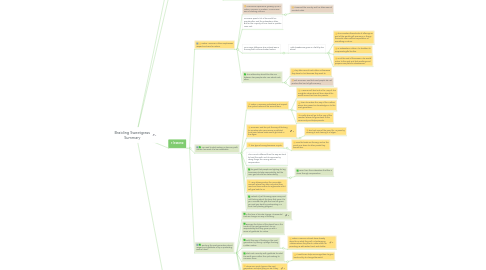
1. 1-Sentence-Summary:
1.1. Braiding Sweetgrass offers some great ways for all of us to take better care of and be more grateful for our planet by explaining the way that Native Americans view and take care of it.
2. Favorite quote from the author:
2.1. "In some Native languages the term for plants translates to 'those who take care of us.'" - Robin Wall Kimmerer
3. 3 lessons:
3.1. Native American culture emphasizes respect and care for nature.
3.1.1. Kimmerer’s experience growing up as a Native American in modern America was one of clashing cultures.
3.1.1.1. It seemed the country and her tribe were at constant odds.
3.1.2. Kimmerer spent a lot of time with her grandmother and the Potawatomi tribe. But for the majority of time lived in upstate New York.
3.1.3. One major difference she noticed was in the way both cultures treated nature.
3.1.3.1. Wild strawberries grew in a field by her school
3.1.3.1.1. She considers these kinds of offerings as part of the world’s gift economy, or things the world offers without expectation of something in return.
3.1.3.1.2. In Potawatomi culture, it is tradition to reciprocate gifts like this.
3.1.3.1.3. So at the end of the season, she would return to the spot and find seedlings and prepare new plots for strawberries.
3.1.4. The relationship should be like one between two people who care about each other.
3.1.4.1. They take care of each other not because they have to, but because they want to.
3.1.4.2. But Kimmerer saw that most people do not practice this kind of gift economy.
3.2. We need to start working in harmony with nature if we want it to be sustainable.
3.2.1. Native Americans understand and respect the cyclical nature of life around them.
3.2.1.1. A woman will start out in the Way of The Daughter, where she will learn about the world around her from her parents.
3.2.1.2. Then she enters the Way of the Mother, where she passes her knowledge on to the next generation.
3.2.1.3. Finally, she will go to the Way of the Teacher, where she gives back to the community and helps parents.
3.2.2. Kimmerer said she put this way of thinking to use when she came across a polluted local pond where birds would get stuck in the algae.
3.2.2.1. She took care of the pond for 12 years by cleaning it and clearing it of algae.
3.2.3. This type of caring becomes a cycle.
3.2.3.1. Now the birds are thriving, and as the pond runs down to other ponds they benefit too.
3.2.4. This is much different than the way we tend to treat the Earth and its resources by doing things like mining with no reciprocation.
3.2.5. It’s great that people are fighting for big businesses to take responsibility, but the main goal should be sustainability.
3.2.5.1. Learn from the Potawatomi that this is done through reciprocation.
3.2.6. Many tribes practice the Honorable Harvest, where they take only what they need and leave nature to regenerate and it will give back to us.
3.2.7. Instead of just throwing paper away and not thinking about the trees that gave it to you, consider the gifts this tree has given you and give back by participating in a local, tree planting program.
3.3. Teaching the next generation about respect and gratitude is key in protecting Earth’s future.
3.3.1. In the face of climate change, it’s essential that we change our way of thinking.
3.3.2. Because the future of the planet lies in the hands of the next generation, it’s our responsibility that they grow up with a sense of gratitude for nature.
3.3.3. Instill this way of thinking in the next generation by having a pledge thanking Mother Nature.
3.3.3.1. Native American schools have already done this in what they call a Thanksgiving Address where they thank Mother Earth for providing us with water, food, and shelter.
3.3.4. Start each new day with gratitude for what the Earth gives rather than just seeking to consume more.
3.3.4.1. It could even help encourage them to give back and try to change the world.
3.3.5. There is so much hope in the next generation and what they can do if they feel more connected to nature.
3.3.6. Only by giving back in the present can we continue to take in the future.
